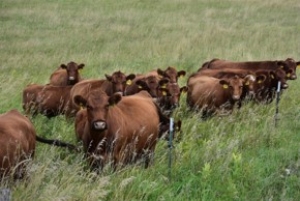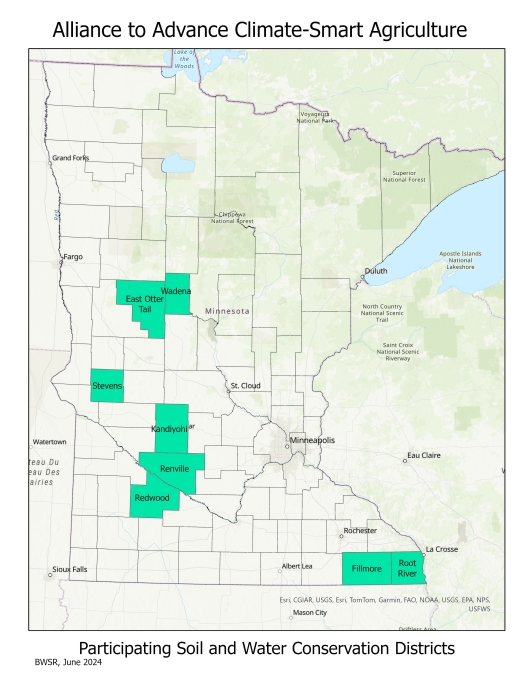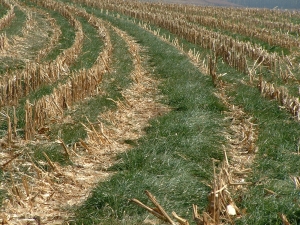Program Summary
The Alliance to Advance Climate-Smart Agriculture is a pilot program funded by the USDA’s Advancing Markets for Producers program that will incentivize and reward farmers and ranchers for adopting climate-smart agricultural practices. It will also undertake research and collect producer and stakeholder feedback to generate guidance for a federal program that could reach all producers in the U.S. Four states are participating: Arkansas, Minnesota, North Dakota, and Virginia. The Virginia Tech College of Agriculture and Life Sciences is administering the project, with participation from each state and many additional partners.
The participating SWCDs in Minnesota are:
- East Otter Tail and Wadena
- Fillmore and Root River (Houston)
- Kandiyohi
- Redwood
- Renville
- Stevens
Landowners and operators in those counties are eligible to receive $100 per acre or animal unit for integrating climate-smart practices into their farming operations.
Third Application Period
The program's third application period ran from June 26 to July 28, 2025. Applications have been evaluated by districts, BWSR and Virginia Tech, and selection of the first group of applicants is pending.
An initial application period in the summer of 2024 resulted in nearly 400 producers receiving funding, for a total of almost $6 million in producer payments.
A second application period was held between January 2 and February 14, 2025, and resulted in over 400 producers receiving funding, for a total of just over $5 million in producer payments.
See the Alliance website for details regarding the application process. Applicants are chosen through a randomized selection process.
Payments to Producers
Landowners accepted into the program receive payments directly from Virginia Tech. Technical and program assistance are provided by the participating SWCDs and contracted advisors.
Applicant Eligibility
Eligible producers can enroll up to 160 acres or animal units in a single farm number (FSA) bundle. Applicants need to provide districts with FSA documentation for each farm number.
Minimum acreage enrollment is 3 acres. Minimum animal unit enrollment is 10 animal units.
Eligible Practices
Because 2026 will be the final year of the program unless an extension is approved by USDA, available practices are limited. Practices (with NRCS practice numbers) are:
- Conservation Crop Rotation (328)
- Cover Crop (340)
- Residue and Tillage Management, No Till (329)
- Residue and Tillage Management, Reduced Till (345)
- Nutrient Management (590)
- Feed Management (592)
Contracts will end on June 20, 2026.
New: CPA-52s Now Required for All Practices
USDA announced on August 28, 2025, that the Advancing Markets for Producers Initiative will follow the normal CPA-52 process for NRCS programs, which includes completing a CPA-52 for every practice. BWSR has developed templates for all practices (see dropdown below) and will be updating instructions for submitting these documents as we learn more.
- Frequently Asked Questions (Updated October 2025)
Update on the shapefile requirements for the Alliance program: Shapefiles are not needed for the second payment. They are needed for CPA-52 practices and for select practices for the third payment:
- No-till
- Reduced till
- Conservation crop rotation
- Cover crops
Shapefiles should be named as ProducerName_State_County_Practice_"shapefile". If a producer has multiple practices, they will need to upload multiple boundaries.
Round 1 producers will have their shapefiles uploaded to the old dashboard; Round 2 producers will have their shapefiles uploaded to the new dashboard.
How long will the Alliance pilot program last?
The program runs from June 2024 through September 1, 2026, with producer contracts ending June 20, 2026. This provides two fall, two spring, and two summer periods for implementation. Consider these windows of opportunity when planning practices and the potential for subsequent applications/contracts.
What is the length of a producer contract?
Contracts for the first two application rounds were one year in length. Round 3 contracts will expire on June 20, 2026 and all practices will need to be implemented prior to this date.
Will there be additional sign-up periods for producers?
A third sign-up has closed; no further sign-ups are currently planned.
If a producer lacks an email account, how can they sign up?
- If a producer doesn’t have an email, a district employee's email can be used. (Note that many communications are sent via email to the producers so please choose an appropriate email address to utilize.)
Can an applicant implement a practice after applying but prior to completing enrollment?
- Due to updated requirements for environmental review, an approved CPA-52 is required for all practices prior to implementation.
How can producers ensure that they are not "doubling up" on enrollment in federal or state conservation programs?
- Producers may not enroll the same practice on the same acres in more than one program. For example, enrollment in the Environmental Quality Incentives Program (EQIP) for cover crops would preclude enrollment in the Alliance program. However, program funds may be used to enhance a practice, especially with respect to early adopters.
- A producer or landowner may enroll in multiple Advancing Markets for Producers projects for different acres, farms or commodities. However, due to each project needing to market the climate-smart commodity with verified greenhouse gas benefits from climate-smart practice implementation, producers and landowners generally cannot enroll in different projects for the same acre unless:
- multiple commodities are produced on that same acre and
- the climate-smart practices and commodities produced are completely separate for each project.
Can a producer enroll for multiple years?
- Yes, producers may reapply for the same field for a second year as long as they are gaining additional greenhouse gas reduction benefits. This can be through the adoption of a different practice or an enhancement to the existing practice. This will be treated like any other application; in other words, it will go through the randomized selection process.
Can a producer change a practice, reduce the acres enrolled, or change field, tract or farm locations?
- Yes, producers can change a land unit or a practice before signing the producer agreement; districts will update the information in the dashboard.
Which practices require the use of RUSLE2 to calculate soil erosion reductions?
- The rule of thumb is that RUSLE2 would apply to any practice that a) specifically calls for SCI/STIR in the practice worksheet, and/or b) occurs on cropland. So that would naturally include cover crop, conservation crop rotation, and both no-till and reduced tillage practices.
- This would also then apply to Nutrient management if implemented on cropland (not pasture/hayland) and if the method/frequency of application of nutrients changes in some way. RUSLE2 doesn't capture rates or type of chemistry in the application, so if that is all that changed from the benchmark to the implementation, RUSLE2 would not be needed because it would show no change.
- If the pasture and hay planting is occurring on land that was cropland immediately prior to the implementation of this practice (i.e., land that is being converted out of cropland into pasture/hay), then RUSLE2 would be useful because it will theoretically show a large improvement in soil retention. If the practice is occurring on land that was pasture/hay in its most recent history, then RUSLE2 would not be needed.
For additional questions and answers, see Frequently Asked Questions - Alliance to Advance Climate-Smart Agriculture (allianceforcsa.org)
- Guidance and Resources for Districts
NEW (November 2025): COMET and PLET Workbooks:
Alliance COMET Workbook (xlsx) - Workbook designed to provide greenhouse gas emission reductions utilizing COMET Planner data, provided in a spreadsheet format.
Alliance COMET Workbook County Level (xlsx) - Workbook designed to provide greenhouse gas emission reductions utilizing COMET Planner data by simply entering the applicable acres of the implemented practice, for the eight participating counties.
Alliance PLET Workbook (xlsx) - Workbook designed to provide pollution reductions utilizing PLET data, provided in a spreadsheet format.
Alliance PLET Workbook County Level (xlsx) - Workbook designed to provide pollution reductions utilizing PLET data by simply entering the applicable acres of the implemented practice, for the eight participating counties.
Partner Guide – For state and district partner use, process and requirements for sign up to contract completion. Access via google drive link shared with district staff. Includes details on FSA documentation.
Producer Guide – Developed for producers to assist with enrollment to contract completion Producer Guide - Alliance to Advance Climate-Smart Agriculture (allianceforcsa.org)
Technical Assistance Guide - Specific information for district partner use.
NEW: Form to submit to local FSA office to allow districts to access producers' required FSA documents: MN FSA Request Form (docx)
NOTE: If district employees have access to an NRCS computer, they can utilize the NRCS CLU (common land unit) database. You should be able to access the CLU, clip it to the applicable units, and submit it, rather than requesting from FSA.
- Training Videos and Slides
NEW: COMET-Farm Training, October 2025:
NOTE: Workbooks for entering COMET and PLET data can be found above under Guidance and Resources for Districts
Alliance Dashboard Overview, Dec. 16, 2024: https://app.screencast.com/cX4xS0X4XSuCp?tab=Details&conversation=ctmVVmml7qDaX6IEkwAHAN
CPA-52 Training, June 14, 2024: https://app.screencast.com/d5cRnuh6ZbpKS?tab=Details&conversation=bQLbs7D8hdgJdGh6CfTFvn
Alliance Reporting Training (COMET, Water Quality, etc.), July 1, 2024: https://app.screencast.com/T5miOJFbLyq6X?tab=Details&conversation=2uzX8EJxLlHCekYASfsvKq
Program Administration and Technical Training, July 11, 2024: (9+) Alliance Programmatic and Technical Training 07 11 2024 - TechSmith Screencast
- Background Documents
Conservation District Scope of Work (pdf)
Alliance RFP (February 2024) (pdf)
Alliance Practices Eligible for Enrollment (March 2024) (pdf)
- Outreach Materials
Social Media Graphic - crops (png)
- Practice Worksheets
These worksheets are now available on the Alliance website
- Conservation Crop Rotation (328)
- Residue and Tillage Management, No Till (329)
- Cover Crop (340)
- Residue and Tillage Management, Reduced Till (345)
- Riparian Herbaceous Cover (390)
- Riparian Forest Buffer (391)
- Silvopasture (381)
- Pasture and Hay Planting (512)
- Prescribed Grazing (528)
- Nutrient Management (590)
- Tree/Shrub Establishment (612)
*This practice requires a CPA-52 Environmental Evaluation Worksheet. Please contact your district for assistance completing this form.
- CPA-52 Templates and Guidance
The practices listed here require submittal of a CPA-52 - an environmental review form. Practices can't be implemented until that form is submitted and approved. As noted above, the process has changed as of August 2025, and new guidance will be posted as it's received.
CPA-52 Guidance (xlsx) UPDATED 10/11/2024
MN CNMP and Nutrient Management Template (xslx)
MN Conservation Crop Rotation Template (xslx)
MN Cover Crop Template (xlsx)
MN Feed Management Template (xlsx)
MN No-Till - Strip Till Template (xlsx)
MN Nutrient Management Template (xlsx)
MN Pasture Planting - Crop Conversion Template (xlsx)
MN Pasture Planting - Existing Pasture Template (xlsx)
MN Prescribed Grazing Template (xlsx)
MN Reduced Till Template (xlsx)
MN Riparian Forest Buffer Template (xlsx)
MN Riparian Herbaceous Cover Template (xlsx)
MN Silvopasture Template (xlsx)
- Participating Districts' Program Information



